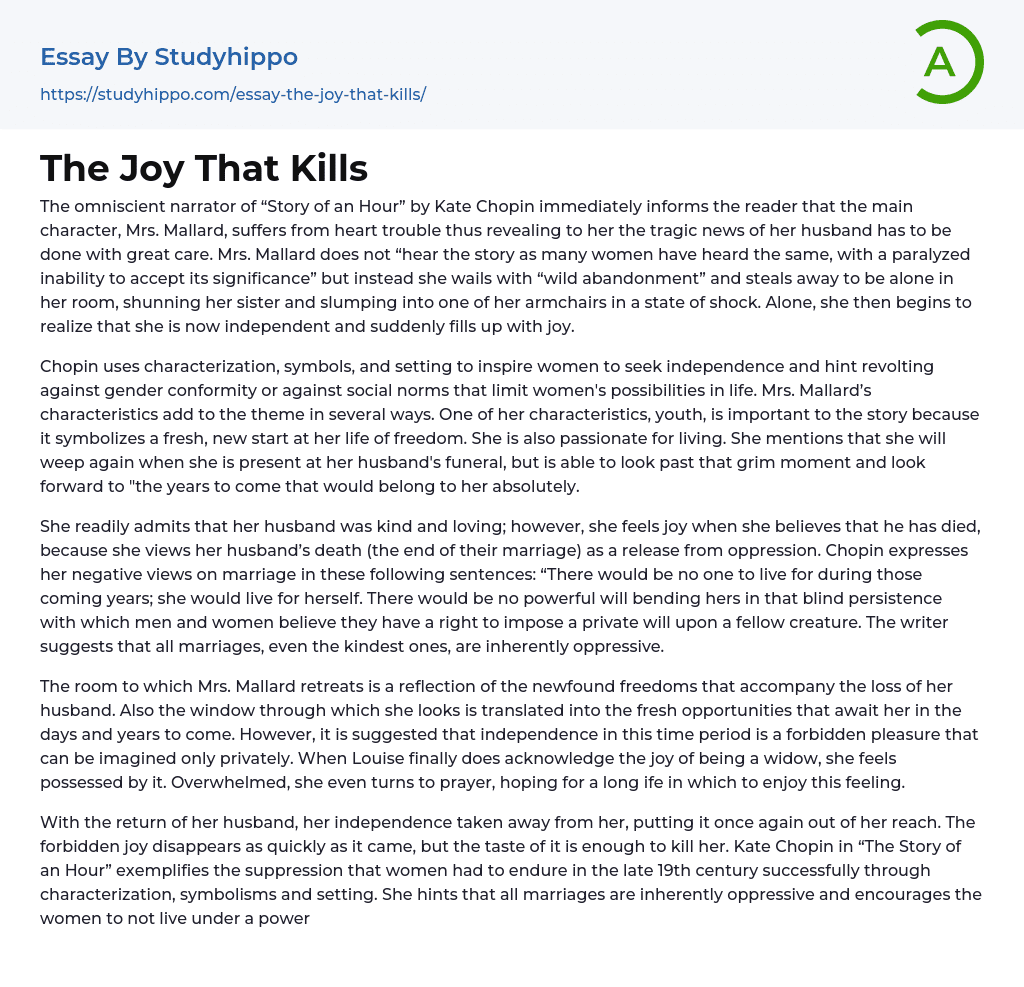The omniscient narrator of “Story of an Hour” by Kate Chopin immediately informs the reader that the main character, Mrs. Mallard, suffers from heart trouble thus revealing to her the tragic news of her husband has to be done with great care. Mrs. Mallard does not “hear the story as many women have heard the same, with a paralyzed inability to accept its significance” but instead she wails with “wild abandonment” and steals away to be alone in her room, shunning her sister and slumping into one of her armchairs in a state of shock. Alone, she then begins to realize that she is now independent and suddenly fills up with joy.
Chopin uses characterization, symbols, and setting to inspire women to seek independence and hint revolting against gender conformity or against social norms that limit wo
...men's possibilities in life. Mrs. Mallard’s characteristics add to the theme in several ways. One of her characteristics, youth, is important to the story because it symbolizes a fresh, new start at her life of freedom. She is also passionate for living. She mentions that she will weep again when she is present at her husband's funeral, but is able to look past that grim moment and look forward to "the years to come that would belong to her absolutely.
She readily admits that her husband was kind and loving; however, she feels joy when she believes that he has died, because she views her husband’s death (the end of their marriage) as a release from oppression. Chopin expresses her negative views on marriage in these following sentences: “There would be no one to live for during those coming years; she
would live for herself. There would be no powerful will bending hers in that blind persistence with which men and women believe they have a right to impose a private will upon a fellow creature. The writer suggests that all marriages, even the kindest ones, are inherently oppressive.
The room to which Mrs. Mallard retreats is a reflection of the newfound freedoms that accompany the loss of her husband. Also the window through which she looks is translated into the fresh opportunities that await her in the days and years to come. However, it is suggested that independence in this time period is a forbidden pleasure that can be imagined only privately. When Louise finally does acknowledge the joy of being a widow, she feels possessed by it. Overwhelmed, she even turns to prayer, hoping for a long ife in which to enjoy this feeling.
With the return of her husband, her independence taken away from her, putting it once again out of her reach. The forbidden joy disappears as quickly as it came, but the taste of it is enough to kill her. Kate Chopin in “The Story of an Hour” exemplifies the suppression that women had to endure in the late 19th century successfully through characterization, symbolisms and setting. She hints that all marriages are inherently oppressive and encourages the women to not live under a powerful will being imposed on them, but to find their own identity and rather live for themselves.
- Book Summary essays
- Metaphor essays
- Reader essays
- Rhyme essays
- Literary devices essays
- Villain essays
- Books essays
- Genre essays
- Literary Criticism essays
- Writer essays
- Protagonist essays
- Simile essays
- Poem essays
- Book Report essays
- Book Review essays
- Greek Mythology essays
- Plot essays
- Tragic Hero essays
- Coming of Age essays
- Play essays
- Rhetoric essays
- Rhetorical Question essays
- Translation essays
- Understanding essays
- Reason essays
- Character essays
- Letter essays
- American Literature essays
- Literature Review essays
- Utopia essays
- Poetry Analysis essays
- Dante's Inferno essays
- Between The World and Me essays
- Incidents in The Life of a Slave Girl essays
- Flowers for Algernon essays
- Myth essays
- Everyday Use essays
- Boo Radley essays
- Genesis essays
- Richard iii essays
- Alice in Wonderland essays
- On the road essays
- Ozymandias essays
- The Nightingale essays
- Holden Caulfield essays
- Animal Farm essays
- 1984 essays
- A Hanging essays
- Shooting An Elephant essays
- A Tale Of Two Cities essays




